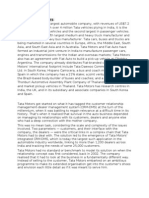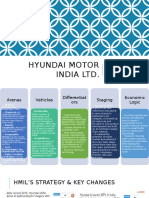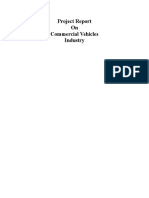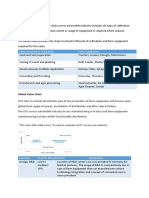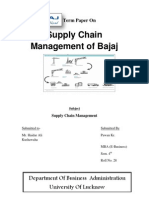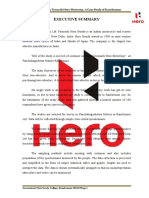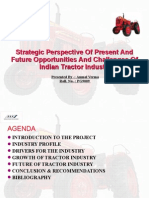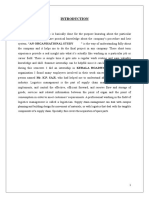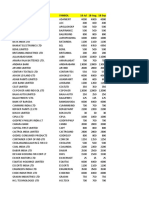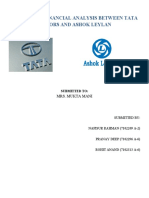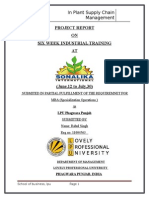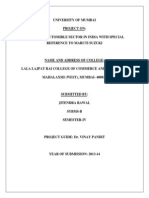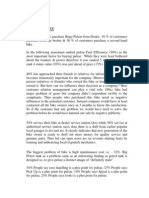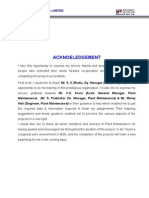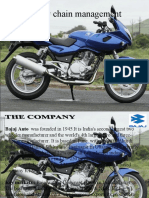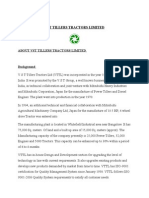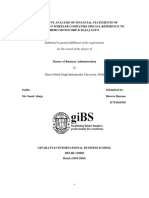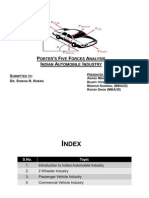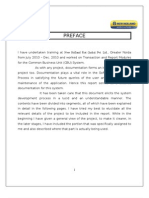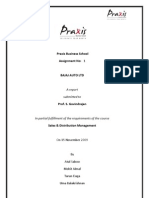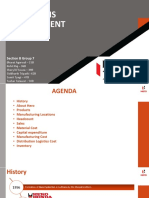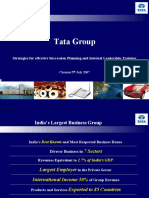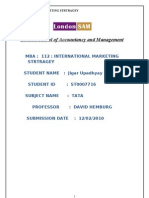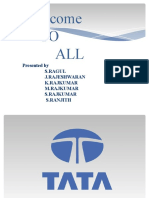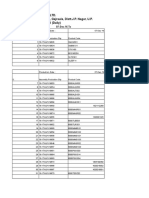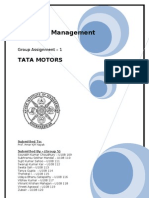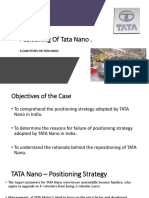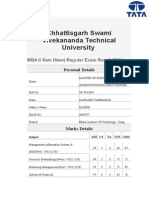Project Report On Commercial Vehicles Industry
Project Report On Commercial Vehicles Industry
Uploaded by
Mansi PrasharCopyright:
Available Formats
Project Report On Commercial Vehicles Industry
Project Report On Commercial Vehicles Industry
Uploaded by
Mansi PrasharOriginal Title
Copyright
Available Formats
Share this document
Did you find this document useful?
Is this content inappropriate?
Copyright:
Available Formats
Project Report On Commercial Vehicles Industry
Project Report On Commercial Vehicles Industry
Uploaded by
Mansi PrasharCopyright:
Available Formats
1
Project Report
On
Commercial Vehicles
Industry
2
CONTENTS
Preface
Executive Summery
Acknowledgement
Evolution and Growth of Industry
Market Size of Industry
Product Mix of Commercial Vehicle Industry in India
Competitive Analysis
Outlook
Declaration
Bibliography
3
PREFACE
Master of Business administration is a course, Which combines both theory and its applications
as its contents of study in the field of management. As part and parcel of thiscourse, every
aspirant has to prepare Market Research Report on particular Industry .The purpose
of this report is to get the in depth knowledge regarding the Industry and enhance students
analytical skills. One of the Indian booming Indian commercial vehicle industry which is
being researched byour group from the management perspective. By studying Indian commercial vehicle
industryfrom a management perspective we would be able analysis potential opportunity as well
asthreats of the commercial vehicle industry. Also, attractiveness of new entrant
would be analysis with the help of Michael Porters five force model. Environmental scanning
would be with the help of PEST analysis (Political, Economic, Social and technology).
The data for analysis is being collected through the secondary sources like internet, Newspaper and published journal.
4
EXECUTIVE SUMMERY
This report is the study of Indian commercial vehicles industry. This report has helped us
togetting some very useful insight of the commercial vehicles industry. Tata Motor, Eicher
Motor, Mahindra & Mahindra,Swaraj Mazda are the dominant player of the Indian commercial
vehicle Industry. India is 13th largest commercial vehicle market in the world. The last five years
industry has grown CAGR of 14%. Commercial vehicles Industrys sharein Indian automobile is
5.05% in the year 2007-08.The i ndus t r y whi c h gr e w a t a r a t e of a bove 25% ove r
2001- 07 ha s gr own b y j us t 5% i n FY 2008, so the economic fluctuation
affect greatly to Indian commercial vehicle Industry. Ability to enhance and vary
product mix, Sales and distribution service network, Access tonew technologies are the key
success factor of Indian commercial vehicle Industry.An Indian railway is the onl y one
competitor of Indian commercial vehicle Industry but because of several advantage
commercial vehicle Industry ruled over the Indian railway.
Inne a r f ut ur e we a r e not s e e i ng a n y s ubs t i t ut e o f c omme r c i a l ve hi c l e I nd
us t r y. I ndi a ncommercial vehicle Industry use sales promotional tool as
marketing tool most and for advertisement the print media is preferred by the most of the
Indian players. Here we got chance to understand the fundamentals of Indian commercial
vehicles industryand also identifies the position of the industry, that how they had
built its image in themarket.
5
ACKNOWLEDGEMENT
I take this opportunity to express my deep sense of gratitude to those who have contributed
significantly by sharing their knowledge and experience in the competition of this project work.
I am greatly obliged to, for providing me with the right kind of opportunity and facilities to
complete this venture.
I am highly thankful to Mr., my faculty under whose able guidance this project work was carried
out. I thank him for his continuous support and mentoring during the tenure of the project
.Finally, I would also like to thank to all my dear friends for their cooperation, advice and
encouragement during the long and arduous task of carrying out the project and preparing this
report.
6
Evolution and Growth of Industry
A Nations economy is well known from its transport system for instant and rapid growth in
economy, a well-developed and well-networked transportation system isessential. As India's
transport network is developing at a fast pace, Indian AutomobileIndustry is growing too. Also,
the Automobile industry has strong backward andforward linkages and hence provides
employment to a large section of the population. Thus the role of Automobile Industry is very
essential in Indian economy. Varioustypes of vehicles are manufactured by the Automobile
Industry. Indian Automobile Industry includes the manufacturing of trucks, buses, passenger cars, defense
vehicles, two-wheelers, etc.
The industry can be broadly segmented into the following category :-
7
Commercial Vehicle (CV) industry in India has surged over the past decade and the market is
expected to grow at a CAGR of over 15% until 2016 (Source: Society of Indian Automobile
Manufacturers (SIAM)) with many companies competing to expand. Commercial vehicle is a
type of motor vehicle that is used for transporting goods or carrying passengers with former
contributing around 87% in India. Commercial vehicles are classified into Light, Medium &
Heavy depending upon its gross vehicle weight. The CV industry enables quick, easy departure
of goods and accepts smaller loads than railways and also commercial vehicles can access
remote and hilly areas where rail lines cannot be constructed.
The main growth drivers for CV Industry are modernization of the trucking industry, structural
shift to Hub & Spoke model, improved road infrastructure, growing freight capacity and increase
in exports from remote areas enabling the producers/manufacturers to move their goods to ports.
The key risk factors for this industry are low freight demand and truck rentals, non-availability of
cargos, fuel price, risk prone area of occupation, sudden transport strike, competition with
alternate mode of transport (Railways) and any new government regulations related to
restrictions based on age of the vehicle and other environmental safety issues. Also, recent study
on CV industry by ICRA found that the Indias GDP and IIP numbers are very closely correlated
with the development of Commercial Vehicle Industry, which in turn has made this industry the
lifeline of Indian Economy.
CV Financing and Securitisation
CV Financing Industry in India has seen an impressive growth and in the last five years till 2012-
13, CV loan disbursements grew by around 11 per cent (Source: CRISIL Research, Retail
Finance- Auto, June 2013). Major players in CV Financing in India are Tata Motors
Cholamandalam Finance, Sundaram Finance, AU Finance, Shriram Transport Finance, Magma,
L&T, M&M and Religare. The key factors that could impact vehicle financing in India are
growth in vehicle sales, finance penetration and average ticket size (players offering marginally
higher LTV because of competition from other players). The process of pooling the loans given
by these CV financiers and selling the securities backed by cash flows from the loans to investors
is termed as Securitization of CV pools and the bank or finance company that has originated
the pool of receivables/loans is termed as Originator. While selecting the loans for
8
securitization, Originator should take into account the factors such as loan tenure, Interest rates,
vehicle type (LCV/UCV), geographical diversity, recovery rates, etc.
Growth of the industry is taking place in clusters. The automotive industry is developing in
clusters. There are four major clusters in the automotive industry in India. They are in and
around New Delhi, Gurgaon and Manesar in North India, Pune, Nasik, Halol and Aurangabad in
West India, Chennai, Bangalore and Hosur in South India and Jamshedpur and Kolkata in East
India. Of course there are several manufacturing units in many other parts of India but these four
clusters are expected to become the main hubs for manufacturing in the automotive industry. The
Government of India (GOI) is taking initiatives to develop the automotive clusters. For example,
the GOI, in its 11th Five Year Plan (20072012), is planning to create the Specialized Education
and Training Institute for the automotive industry. It is also taking measures to enhance
transportation, communication, and infrastructure facilities in these clusters.
After a few years of strong growth, Indias commercial vehicle (CV) industry hit a rough patch
last year, impacted by the overall
economic slowdown, delay in infrastructure projects and weak investment sentiment. However,
the industry has long-term growth
potential, subject to the economy accelerating back to 7%8% GDP growth per annum and the
Government expediting policies that
support growth of manufacturing and infrastructure development. While deregulation of diesel
prices will make the industry less
dependent on subsidies, it is likely to create demand uncertainty in the short-term as truck
owners and manufacturers adjust to the new normal.
9
Market Size Of Industry
Industry performance in 2011-12
Production
The cumulative production data for April-March 2012 shows production growth of 13.83 percent
over same period last year. In March 2012 as compared to March 2011, production grew at a
single digit rate of 6.83 percent. In 2011-12, the industry produced 20,366,432 vehicles of which
share of two wheelers, passenger vehicles, three wheelers and commercial vehicles were 76
percent, 15 percent, 4 percent and 4 percent respectively.
Domestic Sales
The growth rate for overall domestic sales for 2011-12 was 12.24 percent amounting to
17,376,624 vehicles. In the month of only March 2012, domestic sales grew at a rate of 10.11
percent as compared to March 2011.
Passenger Vehicles segment grew at 4.66 percent during April-March 2012 over same period last
year. Passenger Cars grew by 2.19 percent, Utility Vehicles grew by 16.47 percent and Vans by
10.01 percent during this period. In March 2012, domestic sales of Passenger Cars grew by 19.66
percent over the same month last year. Also, sales growth of total passenger vehicle in the month
of March 2012 was at 20.59 percent (as compared to March 2011). For the first time in history
car sales crossed two million in a financial year.
The overall Commercial Vehicles segment registered growth of 18.20 percent during April-
March 2012 as compared to the same period last year. While Medium & Heavy Commercial
Vehicles (M&HCVs) registered a growth of 7.94 percent, Light Commercial Vehicles grew at
27.36 percent. In only March 2012, commercial vehicle sales registered a growth of 14.82
percent over March 2011.
Three Wheelers sales recorded a decline of (-) 2.43 percent in April-March 2012 over same
period last year. While Goods Carriers grew by 6.31 percent during April-March 2012,
Passenger Carriers registered decline by (-) 4.50 percent. In March 2012, total Three Wheelers
sales declined by (-) 9.11 percent over March 2011.
Total Two Wheelers sales registered a growth of 14.16 percent during April-March 2012.
Mopeds, Motorcycles and Scooters grew by 11.39 percent, 12.01 percent and 24.55 percent
respectively. If we compare sales figures of March 2012 to March 2011, the growth for two
wheelers was 8.27 percent.
Exports
During April-March 2012, the industry exported 2,910,055 automobiles registering a growth of
25.44 percent. Passenger Vehicles registered growth at 14.18 percent in this period. Commercial
10
Vehicles, Three Wheelers and Two Wheelers segments recorded growth of 25.15 percent, 34.41
percent and 27.13 percent respectively during April-March 2012. For the first time in history car
exports crossed half a million in a financial year.
In March 2012 compared to March 2011, overall automobile exports registered a growth of
17.81 percent.
11
12
13
14
PRODUCT MIX OF COMMERCIAL VEHICLE INDUSTRY IN
INDIA
AMBULANCE:
Ambulance forms the important category of commercial vehicle. The sole purpose of this
vehicle is to carry the sick and injured persons. Modern-day ambulances are typically
large automobiles on a van or light truck chassis with a maximum road weight up to 7.5
tonnes.
They are categorized into various sub-categories such as Emergency ambulance, Patient
Transport Ambulance, Response Unit and Charity Ambulance depending on their
functional use.
The major producers of these vehicles are-
Force Motors
Traveller Ambulance
Hindustan Motors Ltd
RTV Ambulance
Mahindra & Mahindra Ltd.
Mahindra Voyager Ambulance
Mahindra MM 540 DP Ambulance
Maruti Suzuki India Ltd.
Omni Ambulance
Swaraj Mazda
Swaraj Mazda Ambulance
Tata Motors
Tata Winger
TRUCKS:
Trucks are basically used for carrying goods and materials in bulk. These trucks are
classified into sub-categories like depending on their size and functional use: haulage,
rigid trucks, tippers, cabs, delivery vans and trailers. They come under the intrinsic
15
category of vehicle due to India's growing commercial sector. The fuel efficiency of these
vehicles has also improved to a great extent in the past few years.
The major players of truck manufacturers in India are:
Ashok Leyland
Haulage :
4x2 Haulage Models Multiaxle Vehicles
1613 H 2214 (6X2)
1612 H 2516 H (6X2)
Comet 1611 2514 H (6X2)
1613H/2 (12M Goods) 2516 H (6X 4)
4/51GS 2516H/4C
1613 S
1616 H
1616H - BS III
Hippo Haulage Beaver Haulage
Tippers :
Hippo Tipper Stallion Mk III Tipper
4x2 and Multixled Tippers
CT 1613 H/1 (4X2)
Taurus 2516/2 (6x4)
1613 ST (4x2)
Taurus HD 2516MT/1 (6x4)
CT 1613 H/2 (4x2)
Rigid Trucks :
Beaver Tractor Hippo Tractor
Ecomet
Ecomet 912
Ecomet 1112
Force Motors
Haulage :
CLA 40.280 CLA 49.280
Hindustan Motors Ltd.
Rigid Trucks :
Mascot T-480 FC Pick-Up Cargo
Porter Plus
Mahindra & Mahindra Ltd.
Cabs :
Pic-Up Range Hard Top Range
Mahindra Utilty Mahindra Economy
Mahindra Pik-up Mahindra Marshal DI
16
Mahindra NC640DP Mahindra 775 XDB
Pik-Up CBC
Mahindra 3door Hard Top
Mahindra 5door Hard Top
LCV Range
Mahindra CabKing 576
Mahindra DI 3200
Mahindra Cab King 576 DI
Mahindra Load King DI
Maxx Maxi Truck
Delivery Van
Mahindra Voyager Delivery Van
Swaraj Mazda
Rigid Trucks :
Sartaj V W 26-S Premium Truck Swaraj 4 Wheel Drive
Applications
Super ZT54 Swaraj Mazda Water Tank
Tata Motors
Rigid Trucks :
Tata Motors' Range of Tata Ace
'World Trucks'
Rigid Trucks Tata Novus
LPT 1109 Turbo Truck
LP 1109 Turbo Truck
TL 4x4
SFC 407 Ex Turbo Truck
SFC 407 Turbo Truck
LPT 709 E Truck
LPT 407 Turbo Truck
SFC 709 E Aerial Lift Turbo Truck
Pic-Up
Tata Xenon XT
Volvo
Rigid Trucks
Volvo FM Volvo FH
Tippers
Volvo FM9 Tippers
FM400 8x4 Tipper
M340 6x4 Tipper
17
TRACTORS:
Tractors are heavy vehicles serving the purpose of hauling at an extremely low speed.
India being one of the major agricultural countries makes the use of tractors on a large
scale. It is one of the heaviest vehicle basically used for carrying out the agricultural
tasks in an effective way. Modern tractors usually employ diesel engines which delivers
18 to 575 horsepower
The major producers of tractors in India are:
Escorts Ltd.
Farmtrac Powertrac
Farmtrac 45 Powertrac 430
Farmtrac 50 Powertrac 435
Farmtrac 60 Powertrac 440
New Farmtrac 70 Powertrac 455
Force Motors
Balwan Tractor
Balwan 300
Balwan 400
Balwan 450
Balwan 500
OX 25
Swaraj Enterprise
Swaraj Tractor Swaraj Forklift Tractors
Swaraj 722 Super Swaraj EL. Forklift 15
Swaraj 724 FE Swaraj Forklift 15
Swaraj 733 FE Swaraj Forklift 20
Swaraj 735 FE Swaraj Forklift 30
Swaraj 744 FE
Swaraj 834 FE Swaraj Harvester Combine
Swaraj 855
Swaraj 939 FE
Sonalika Tractors
DI 35 DI 55
DI 60 2WD DI 60 4WD
DI 60 Senior DI 75 2WD
DI 75 4WD DI 90 4WD
DI 340 S DI 730 II
DI 730 III DI 732 III
DI 735 DI 740
DI 740 III DI 745 III
DI 750 DI 750 II
DI 750 III
18
Mahindra Kisanmitra
Mahindra Arjun Mahindra Bhoomiputra
Arjun 445 DI Bhoomiputra 265 DI
Arjun 605 DI Bhoomiputra 275 DI TU
Arjun 555 DI
Bhoomiputra 475 DI
Bhoomiputra 575 DI
Mahindra Sarpanch Mahindra Yuvraj
Sarpanch 265 DI
Sarpanch 275 DI TU
Sarpanch 475 DI
Sarpanch 585 DI
Sarpanch 575 DI
Sarpanch 595 DI Super Turbo
HMT Tractors
HMT Yuva 2522 FX
2522 OS 3522 CS
3522 DX 3522 FX
4022 4922
4922 DX 6522
7511
Tafe Tractors
MF 241 Eagle MF 1035 DI
MF 1035 Std. MF 5245 Mahaan
Tafe 25 DI Tafe 30 DI
TAFE 4410 Samrat Tafe 5900 DI Gajraj
Tafe 8502 - 4WD
Indofarm Tractors
Indo Farm 2030 DI Indo farm 2035 DI
Indo farm 2040 DI Indo farm 2050 DI
BUSES:
A bus is a huge commercial vehicle, said to have originated in France in the year 1826 by
StanislasBaudry under the name of 'Omnibus'. The basic purpose of this vehicle is to carry
the passengers as it is an easy and cost-effective medium of transport.
The major producers of buses in India are Ashok Leyland and Tata Motors whereas Swaraj
Mazda and Hindustan Motors have made a big name in manufacturing mini-buses.
However there are huge sub-categories of buses like-Commuter Bus, School buses,
Electric buses and so on. In India,CNG buses have occupied the huge market thus making
it an fuel efficient and environmental friendly vehicle.
19
The major players in this sector are:
Ashok Leyland
Airport Tarmach Coach Cheetah BS-II Cheetah BS-III
Double Decker Lynx BS-II Panther BS-II
Stag-BS II Vestibule Bus Viking BS-II
Viking BS-III Viking CNG BS-III Viking SLF BS-III
12-M Bus-II 12-M Bus
Eicher
Skyline Bus School Bus Cruiser
Skyline CNG Bus
Force Motors
Citiline 25+D Citiline School Bus (25+D) Commuter 32+D
Traveller Mini Bus 14
+D Traveller Long 17+D
Hindustan Motors Ltd.
RTV Custom RTV Passenger RTV School Bus
Mahindra & Mahindra Ltd
Mahindra FJ Minibus Mahindra FJ 470 Tourister 15
Swaraj Enterprise
Bus CNG Bus LHD Bus
School Bus
Tata Motors
Starbus Other Buses
StarbusSkool SFC 407 Turbo Mini-Bus
StarbusSkool 17 LPO 1510 CGS Bus (CNG Bus)
StarbusSkool 32 LP / LPO 1510 Bharat stage II Bus
StarbusSkool 52
LPO 1616 TC Luxury Bharat Stage - II
Bus
Starbus Low Floor Globus
Starbus LF Globus 13
Starbus ULF CNG Globus 18
Starbus Standard Globus 20
Starbus 16 Globus 45
Starbus 18 CNG
Starbus 20
20
Starbus 32
Starbus 54
Starbus 67
Starbus Deluxe
StarbusDlx 18
StarbusDlx 20
StarbusDlx 28
StarbusDlx 35
Competitive Analysis
Two decades ago, India opened its doors for multinational automobile companies allowing them
topenetrate the market, modernize the Indian transportation picture and make it beneficial for the
end-users.
The India Commercial Vehicle Market Analysis observed that the commercial vehicle segment
of the Indianautomobile industry has shown great recovery after withstanding the effects of the
global economic crisis.With economic revival, increasing public & private spending on
infrastructure and higher penetration offinancing facilities, we expect the growth trend in each
segment of commercial vehicles to continue in thecoming years. As per our analysis, LCV goods
carrier is the fastest growing segment that is estimated toregister a sales growth of around 20%
during FY 2012-FY 2015.
Our report has studied the Indian commercial vehicle market from various perspectives. It
facilitatesinformation on production, sales, exports and key players in each segment (M&HCV,
LCV and threewheelers)that has been further divided into passenger carrier and goods carrier
sections. A comprehensivestudy on commercial vehicle tyre has also been included in the
extensive research, which also foreseesgrowth in CV auto component industry.
We observed that hub and spoke model and small commercial vehicles are among the major
trends whichwould drive the Indian CV market in near future. During the regional analysis, it
was found that South Indialeads the country in terms of commercial vehicle market. Besides, the
growth in the CV industry will boostup demand for used commercial vehicles in coming years.
With a view to understanding the industry's competitive landscape and presenting its balanced
outlook toclients, we have included profiles of key players like Tata Motors and Ashok Leyland
in our research study.
21
MAJOR PLAYERS OF INDIANCOMMERCIAL VEHICLE INDUSTRY
22
Mahindra & Mahindra (M&M):
M&M is the dominant player in multi utility vehiclesegment. In UV market The Company has
around 51% market share in FY08. M&M has amarket share of 11.2% in C-segment cars during
FY08. M&M is second biggest player in theIndian LCV segment. The company has recently
announced an investment of Rs 15 billion inthe upcoming Greenfield Chakan facility in Pune. It
plans to use the capacity for the production of LCV, M&HCV and UV at this plant with the
initial capacity of around 2.5 lakhunits.
ASHOK LEYLAND
Ashok Leyland (ALL): ALL is the second-largest commercial vehicles manufacturer
in India.The company plans to increase the installed capacity from 84,000 vehicles in FY08
to184,000 vehicles by FY10 with a capital expenditure of Rs 30 billion over the next threeyears.
Nissan Motor and ALL have stepped up planned investment in their three new jointventure
companies to $575 million. The JV will set up manufacturing capacity of one lakhvehicles in the
first phase which would be scaled up subsequently. The plant is expected tostart production by
FY10-11
Tata Motors
Tata Motors (TML): TML is the worlds fifth largest and Indias largest medium and
heavycommercial vehicle manufacturer. The company has plants in Jamshedpur, Pune,
Lucknow, andDharwad and R&D centers in Pune, Jamshedpur, and Lucknow in India and in
South Korea, Spain and the UK. The company markets its products in Europe, Africa, Middle
East, South Asia, South East Asia and Australia. Tata Motors has planned a capacity of 2.25 lakh
units for Ace, the sub-one-tonne truck, while the existing capacity in Pune is just around 60,000
units a year. Recently, TML has acquired Jaguar and Land Rover from Ford Motors for $2.3
billion.
23
Eicher Motors (EML):
EML produces commercial vehicles including trucks, buses, motorcycles, automotive gears and
components. The company has sold 8.1% of promoters holding to Swedish bus maker Volvo to
form a joint venture, in which Volvo will pump upRs 1,082 crores. The JV would be a subsidiary
of EML, where Eicherwould hold
54.4%equity and Volvo 45.6%. The manufacturing facility of Eicher Motors is located inPitham
pur, Madhya Pradesh. The plant houses some top-of-the-line equipments, a robust infrastructure
and has an annual production capacity of 30,000 vehicles. The company is one of the leading
manufacturers of commercial vehicles in India with a 33% market share in the7T-11T segment.
Eicher motor is another leading company in commercial vehicle Industry although we
cannotcompare it with Tata motor as EMLs market share is not more than 10% in any segment
of Indian commercial vehicle industry. Eicher motors highest market share in medium andheavy
commercial vehicle segment it has 9 % market share in multi and heavy goods carrier.
24
Outlook
Growth:
although rise in interest rates and fuel price may dampen the growth of the sector in short run and
long run:-
term outlook for the domestic cv industry remains strong. The expectedcontinuance of economic
growth and investments in infrastructure will help the sector report r obus t gr owt h goi ng
f or wa r d. t he e nt r y of ne w pl a ye r s i n t he i ndus t r y a nd t he
s i gni f i c a nt capacity additions expected are however likely to keep the competitive pressures
high. on thede ma nd s i de , a c ombi nat i on of t i ght e ni ng r e gul a t or y nor ms ( on
e mi s s i ons a nd ve hi c l e s c r a ppi ng) a nd i nc r e a s i ng c us t ome r s e l e c t i vi t y i s
e xpe ct e d t o dr i ve a s hi f t t owa r ds hi gh tonnage quality products. The top players
in the domestic cv industry have robust financials, s uppor t e d by s t r ong c a s h a c c r ua l s
a nd a c omf or t a bl e c a pi t a l s t r uc t ur e . The s e pl a ye r s a r e capable of funding their
significant investment plans over the medium term without resorting t o a ny l a r ge
bor r owi ngs . Mor eove r , t he ongoi ng c a pa c i t y e xpa ns i ons a r e ba s e d
l a r ge l y on outsourcing models, which aim at better sharing of risks with component suppliers
and lower the break-even levels. The significant export drives being made by the leading cv
players are likely to lower the risks arising from concentration on the domestic market and
mitigate the impact of cyclical downturns to an extent
25
Rising commercial vehicle loan defaults increase risk for lenders
The inevitable fallout of the long decline in commercial vehicle (CV) sales is the rise in
delinquencies in loans to this sector. Prolonged sluggishness in the economy along with high
interest rates has led to defaults of commercial vehicle loans. Obviously, this puts at risk the non-
banking finance firms, which have a reasonably high exposure to this segment.
A report by India Ratings and Research Pvt. Ltd says that for the quarter ended September,
the weighted average of 90-plus days dues rose by 23% from the immediate preceding quarter
to 3% of the loans. An earlier report by Equifax Credit highlighting the 30-day outstanding loan
delinquencies were up by about 18% in the first half of fiscal year 2013.
The data is backed by the corporate results of leaders in CV lending. Shriram Transport
Finance Co. Ltd reported a margin decline, albeit a small one, compared with the June quarter,
mainly due to high cost of borrowing, growth moderation in assets under management and
inching up non-performing assets. Non-banking financial companies in this segment like
Cholamandalam Investment and Finance Co. Ltd and Sundaram Finance Ltd have reduced
the loan amount given as a percentage to value of the asset and tightened eligibility norms.
But risks on existing assets continue to rise. A report from Antique Stock Broking Ltd points
out some worrisome trends in the industry. Utilization of trucks has fallen as number of trips per
month has come down to six from 10, with no return trip. This has strained cash flows of
transporters. Delay in payment of loan instalments has spread from heavy trucks to even
intermediate and light CVs.
The deteriorating fundamentals of finance firms are due to all-round sluggishness in the
economy, ranging from agricultural product movements to industrials, mining and infrastructure.
More worrisome is the recently noticed trend of rise in early delinquency rate against a
scenario of stable repayment of loans at least in the first two to three years. The handful
of listed firms has shown stress on cash flows in the last several quarters, which is
unlikely to improve immediately, in spite of improved collection procedures and lending
norms.
Meanwhile, year-till-date sales volume of trucks is down 27% compared with a year ago
for Ashok Leyland Ltd and Tata Motors Ltd.
A rise in truck rentals, which has been falling for many months, will bring hope. A 3-4%
rise in truck rentals seen in the last two months, however, could be due to arrival of the
agricultural harvest. This is too early to signal a revival.
26
BIBLIOGRAPHY
http://www.icra.in/Files/ticker/SH-2013-Q1-1-ICRA-Commercial%20Vehicles.pdf
http://www.indiacommercialvehiclesummit.com/
http://www.ey.com/IN/en/Newsroom/News-releases/PR_Mega-trends-shaping-the-
Indian-commercial-vehicle-industry
You might also like
- CRM of Tata MotorsDocument5 pagesCRM of Tata MotorsHomiyar Talati100% (2)
- Maruti SuzukiDocument79 pagesMaruti SuzukiSamuel Davis100% (1)
- Bajaj Auto Rural MarketingDocument17 pagesBajaj Auto Rural MarketingKunal Agarwal100% (1)
- Force Motors - Strategy PresentationDocument14 pagesForce Motors - Strategy PresentationRahul Yadav67% (3)
- Hyundai Motors IndiaDocument31 pagesHyundai Motors Indiashiva198920060% (1)
- Project Report On Commercial Vehicles IndustryDocument26 pagesProject Report On Commercial Vehicles IndustryVivekNo ratings yet
- The Mckinsey Way Ethan M. Rasiel: Gaurav Rathi (09016) Priyadarshini N (09035Document26 pagesThe Mckinsey Way Ethan M. Rasiel: Gaurav Rathi (09016) Priyadarshini N (09035gauravrathi2685% (13)
- TataElxsi Vs LTTS Investyadnya 20210607Document74 pagesTataElxsi Vs LTTS Investyadnya 20210607Financial WisdomNo ratings yet
- TATA MOTORS ASSIGNMENT - FinalDocument9 pagesTATA MOTORS ASSIGNMENT - FinalSamiraNo ratings yet
- A9 - Marketing Management - Project Part 1Document11 pagesA9 - Marketing Management - Project Part 1malvika_varma100% (1)
- Full ProjectDocument58 pagesFull ProjectKing KrishNo ratings yet
- Bajaj Auto Manufacturing FacilitiesDocument7 pagesBajaj Auto Manufacturing FacilitiesMohit NarayanNo ratings yet
- Two Wheelers in IndiaDocument31 pagesTwo Wheelers in Indiasarath.nNo ratings yet
- Agriculture Equipment Industry AnalysisDocument5 pagesAgriculture Equipment Industry AnalysisRaasam SiddharthNo ratings yet
- Sonalika Training Report 55844bbf6e2a7Document54 pagesSonalika Training Report 55844bbf6e2a7ShubhamKumarNo ratings yet
- Bajaj Auto LTD Supply ChainDocument27 pagesBajaj Auto LTD Supply ChainPawanLUMBA100% (1)
- Executive Summary: Customer Satisfaction Towards Hero Motocorp, A Case Study of RanebennurDocument51 pagesExecutive Summary: Customer Satisfaction Towards Hero Motocorp, A Case Study of RanebennurSarva ShivaNo ratings yet
- Hyundai SCM01Document12 pagesHyundai SCM01Harsh BajpaiNo ratings yet
- Tractor Industry Present and FutureDocument45 pagesTractor Industry Present and Futureanmol100% (4)
- 22th July 2013 (A Case Analysis Os S.alam Group of Company)Document25 pages22th July 2013 (A Case Analysis Os S.alam Group of Company)Nazrul IslamNo ratings yet
- Article On 'Backhoe Loader Industry in India' by Chaitanya Raj GoyalDocument10 pagesArticle On 'Backhoe Loader Industry in India' by Chaitanya Raj GoyalChaitanya Raj GoyalNo ratings yet
- Internship KRS NEW EDITEDDocument31 pagesInternship KRS NEW EDITEDMOHAMMED ADIL100% (1)
- Project On Sai HondaDocument20 pagesProject On Sai Hondapradip_kumarNo ratings yet
- List of Futue and Options Stocks With Lot SizeDocument6 pagesList of Futue and Options Stocks With Lot SizesureshNo ratings yet
- Mahindra Tractor MarketingDocument61 pagesMahindra Tractor MarketingBadru DeenNo ratings yet
- EVA - Indian Automobile IndustryDocument30 pagesEVA - Indian Automobile IndustryleoatcitNo ratings yet
- Project On Financial Analysis Between Tata Motors and Ashok LeylanDocument23 pagesProject On Financial Analysis Between Tata Motors and Ashok LeylannafisurNo ratings yet
- India - Commercial Vehicle Industry - June 2022Document31 pagesIndia - Commercial Vehicle Industry - June 2022Anupam Tripathi100% (1)
- Sonalika Group Is One of The Top Automobile and Agriculture MachineryDocument53 pagesSonalika Group Is One of The Top Automobile and Agriculture MachineryRahul Singh67% (3)
- Maruti Suzuki AutomobileDocument80 pagesMaruti Suzuki AutomobileRahul BhansaliNo ratings yet
- Maruti Suzuki India LimitedDocument40 pagesMaruti Suzuki India LimitedGokul KrishnakumarNo ratings yet
- Honda Hero BajajDocument76 pagesHonda Hero BajajSubramanya DgNo ratings yet
- Agro Base Equipment Sector: A Project Report ONDocument37 pagesAgro Base Equipment Sector: A Project Report ONrahul_golaitNo ratings yet
- 03 - Review of LitretureDocument9 pages03 - Review of LitretureHarsh AgarwalNo ratings yet
- CONCLUSIONSDocument7 pagesCONCLUSIONSujvalda0% (1)
- Industrial Tarining BY Rohit Thakur ROLL NO. 81404114070 Mechanical EngineeringDocument61 pagesIndustrial Tarining BY Rohit Thakur ROLL NO. 81404114070 Mechanical EngineeringSimranpreet Singh100% (1)
- Maruti Suzuki Project ReportDocument80 pagesMaruti Suzuki Project Reportrajwarmanish1980362No ratings yet
- Bajaj Supply ChainDocument16 pagesBajaj Supply ChainavadhutgNo ratings yet
- Samyak Agarwal (M-703) - Vaibhav Agarwal (M-704)Document31 pagesSamyak Agarwal (M-703) - Vaibhav Agarwal (M-704)Vaibhav AgarwalNo ratings yet
- History and Development of Amul Indusries Pvt. Ltd.Document79 pagesHistory and Development of Amul Indusries Pvt. Ltd.asn8136No ratings yet
- About VST Tillers Tractors LimitedDocument9 pagesAbout VST Tillers Tractors Limitedrajeshthumsi100% (1)
- BAJAJ Distinctly AheadDocument17 pagesBAJAJ Distinctly AheadShipra AmeriyaNo ratings yet
- Hero, Moto Corp - Monu EditedDocument58 pagesHero, Moto Corp - Monu Editedgoswamiphotostat0% (1)
- Industry ProfileDocument20 pagesIndustry ProfileShanu shriNo ratings yet
- Research PaperDocument97 pagesResearch Paperakshay gangwaniNo ratings yet
- A Study On Customer Preference and Satisfaction Towards Bajaj BikesDocument39 pagesA Study On Customer Preference and Satisfaction Towards Bajaj BikesAjay Savaliya0% (1)
- Ashok LeylandDocument13 pagesAshok LeylandDiptiNo ratings yet
- 34 Tvs Apache in ShimogaDocument102 pages34 Tvs Apache in Shimogaavinash_s1302No ratings yet
- Project On Tvs Vs BajajDocument63 pagesProject On Tvs Vs BajajSk Rabiul Islam100% (1)
- Yamaha FZ, Mini ProjectDocument66 pagesYamaha FZ, Mini ProjectNishanth C Mohan100% (3)
- Two Wheeler Industry HERO MOTO CORP & BAJAJ AUTO LTD (ROLL NO 39)Document16 pagesTwo Wheeler Industry HERO MOTO CORP & BAJAJ AUTO LTD (ROLL NO 39)sakshiNo ratings yet
- Project On TVS Jupiter V/s Honda Activa: Introduction To Indian Two-Wheeler SectorDocument64 pagesProject On TVS Jupiter V/s Honda Activa: Introduction To Indian Two-Wheeler Sectorkamlesh rajputNo ratings yet
- TATA Motors - MBA Summer Training Project Report - Consumer Perception and Analysis of Future..Document56 pagesTATA Motors - MBA Summer Training Project Report - Consumer Perception and Analysis of Future..Munna Munna100% (1)
- Porter's Five Forces Analysis - Indian Automobile Industry 2Document60 pagesPorter's Five Forces Analysis - Indian Automobile Industry 2Ashish Mendiratta50% (2)
- Mahindra Logistics Business CaseletDocument3 pagesMahindra Logistics Business CaseletPritam MukherjeeNo ratings yet
- Project ReportDocument134 pagesProject ReportPrashant Rajpoot100% (2)
- Maruti Suzuki MM ProjectDocument22 pagesMaruti Suzuki MM ProjectShrawan JainNo ratings yet
- A Project Study Report On: P.L. Hyundai, JaipurDocument74 pagesA Project Study Report On: P.L. Hyundai, Jaipurrahulsogani123100% (1)
- Final Part 3Document53 pagesFinal Part 3Alisha ChawlaNo ratings yet
- Dream Company ITCDocument9 pagesDream Company ITCamandeep152No ratings yet
- Bajaj Auto FinalDocument35 pagesBajaj Auto Finalmohit.almal100% (3)
- Fundamental Analysis of Bajaj Auto LTDDocument20 pagesFundamental Analysis of Bajaj Auto LTDnitumfc100% (1)
- John Deere 2Document15 pagesJohn Deere 2akhileahNo ratings yet
- Hero Operation ManagementDocument18 pagesHero Operation ManagementtushartatawatNo ratings yet
- Assignment On The Answer of The Questions of "Case Study of Strategic Evaluation and Control"Document9 pagesAssignment On The Answer of The Questions of "Case Study of Strategic Evaluation and Control"Mohiuddin MuhinNo ratings yet
- Tata Group: Strategies For Effective Succession Planning and Internal Leadership TrainingDocument24 pagesTata Group: Strategies For Effective Succession Planning and Internal Leadership TrainingBhulakkadNo ratings yet
- Lumax Auto Technologies Limited: Illuminated PerformanceDocument8 pagesLumax Auto Technologies Limited: Illuminated Performancemohammad shabuddinNo ratings yet
- London School of Accountancy and Management: International Marketing StrtrageyDocument13 pagesLondon School of Accountancy and Management: International Marketing StrtrageyNikunj BhavsarNo ratings yet
- Automotive Industry in India PDFDocument25 pagesAutomotive Industry in India PDFDeepak Rai75% (4)
- Tata PPTDocument23 pagesTata PPTvgl tamizhNo ratings yet
- Study of Variables Influencing Purchase of Tata Nano With Respect To Driving Schools in Bangalore CityDocument80 pagesStudy of Variables Influencing Purchase of Tata Nano With Respect To Driving Schools in Bangalore CityNihar DesaiNo ratings yet
- A Ratio Analysis Report On FINALDocument34 pagesA Ratio Analysis Report On FINALArsal AliNo ratings yet
- Asp Sealing Products Ltd. A-7, UPSIDC Industrial Area, Gajraula, Distt.J.P. Nagar, U.P. Assembly Production Detail (Daily)Document8 pagesAsp Sealing Products Ltd. A-7, UPSIDC Industrial Area, Gajraula, Distt.J.P. Nagar, U.P. Assembly Production Detail (Daily)Sikha KaushikNo ratings yet
- Strategic Management Short Project For Tata MotorsDocument18 pagesStrategic Management Short Project For Tata MotorsSujit72% (18)
- Company Law and Corporate Governance - Cia 3Document12 pagesCompany Law and Corporate Governance - Cia 3harjas singhNo ratings yet
- Consolidated Company List December 2018Document478 pagesConsolidated Company List December 2018Rishabh GhaiNo ratings yet
- Tata NanoDocument10 pagesTata NanoHuzaifa AzizNo ratings yet
- FiatDocument56 pagesFiatOmkar Parkar0% (1)
- (Eng) India's EV Scenario - Trends and Opportunities FY23 (Final)Document45 pages(Eng) India's EV Scenario - Trends and Opportunities FY23 (Final)RamkumarNo ratings yet
- PRICE LIST W.E.F. 01-MAY - 2021 Field Coils For Starter MotorDocument2 pagesPRICE LIST W.E.F. 01-MAY - 2021 Field Coils For Starter MotorKeyur PanchalNo ratings yet
- MarketLineIC - Jaguar Land Rover Automotive PLC - Profile - 061221Document19 pagesMarketLineIC - Jaguar Land Rover Automotive PLC - Profile - 061221Rama IlanagaiNo ratings yet
- HRM 2Document22 pagesHRM 2Shruti JainNo ratings yet
- AutomotiveDocument10 pagesAutomotiveumesh kumarNo ratings yet
- "Financial Ratio Analysis of Tata Motors": Title of The ProjectDocument50 pages"Financial Ratio Analysis of Tata Motors": Title of The ProjectRakesh SahNo ratings yet
- Ratan Tata The Soft-Spoken Man of SteelDocument14 pagesRatan Tata The Soft-Spoken Man of SteelharshjaipuriyaNo ratings yet
- History of Tata MotorsDocument34 pagesHistory of Tata Motorspappucan100% (1)
- List of Truck ManufacturersDocument8 pagesList of Truck Manufacturerssjk_srNo ratings yet
- Cost Reduction in Tata Motors Through Effective Supply Chain ManagementDocument16 pagesCost Reduction in Tata Motors Through Effective Supply Chain ManagementAditya KhuntetaNo ratings yet
- Annual Report 2021 22Document446 pagesAnnual Report 2021 22rohit koyandeNo ratings yet
- Customer RetentionDocument54 pagesCustomer RetentionSaurabhTamrakar0% (1)
